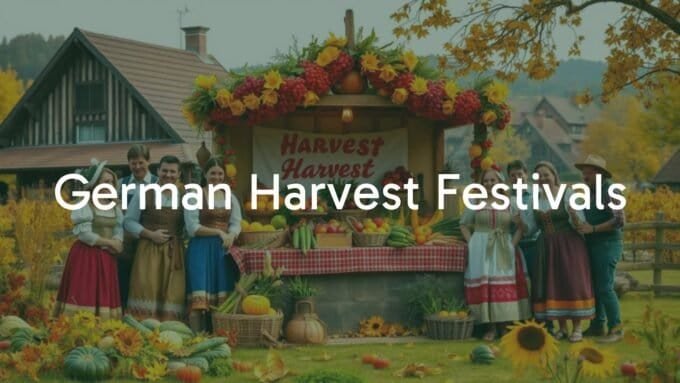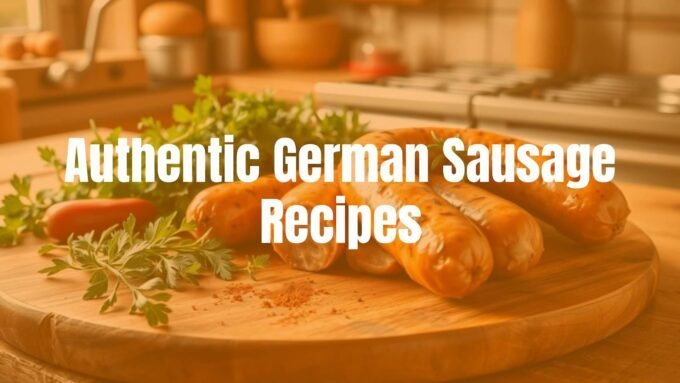German food is often thought of as just sausages and sauerkraut, but there is actually a wide range of dishes and flavors across different regions of Germany. Each part of the country has its own cooking styles and special foods shaped by local history, land, and cultural traditions. In this article, we’ll go through how and why German food is so different from one place to another, and what makes each region’s cuisine special.
From meat-heavy Bavarian meals in the south to seafood dishes on the northern coast, and from the French-inspired foods in the west to eastern Germany’s simple but creative cooking, each area of Germany has dishes that tell its own story. Learning about these food differences helps you understand more about Germany’s background and its sixteen individual states.
What Makes German Food Different in Each Region?
German food varies so much because of the country’s history, land, and local customs. Before 1871, Germany wasn’t one country – it was many small kingdoms and city-states, each with their own ways and recipes. That old split still affects how people cook and what they eat in each area. People are very proud of their traditional dishes and still follow many local ways of cooking.

The geography and weather also play big roles. Germany has flat coastlines in the north, mountains in the south, and everything in between. What could be grown, raised, or caught depended on the land and climate in each area. For example, coastal areas used lots of seafood, while places with rich farmland used more grain and dairy. Over time, these differences have created a wide range of local food traditions.
Main Factors Behind Food Variety in Germany
- Historical political borders: Because Germany was split into many little countries for centuries, each one made up its own recipes and food styles. Today, dishes that started in those old states are still found in their regions.
- Natural resources: Where the land supports fishing, seafood is popular. In regions with good farmland and grazing land, meat, fresh vegetables, and dairy are common. Local crops, like asparagus in Brandenburg or wine grapes in the Rhineland, end up in dishes from these areas.
- Neighboring countries: German regions near France, Italy, Eastern Europe, or Scandinavia have borrowed ideas and ingredients, blending them into local food traditions.
How Geography, Climate, and History Influence Dishes
The land and weather shape what people eat. Northern Germany has cool, damp weather – perfect for root vegetables and grains like rye, plus easy fishing. The south, warmer and sunnier, can grow more fruit and has a bigger variety of fresh foods. In the past, people mostly used what they could grow or find nearby.
Close borders with other countries also brought new flavors. For example, the Rhineland’s food was shaped by France and Belgium, giving dishes a mix of sweet and sour flavors. Eastern Germany has influences from Russia and Poland, with more preserved and filling foods. Each region’s food tells the story of its land and its history.
How Has History Shaped Food Traditions in Germany?
Germany’s history isn’t just important – it’s the reason for many differences in food. The country only became one nation in 1871. Before that, every kingdom set its own rules, cooked in their own ways, and made dishes that were sometimes unknown just a few hours’ travel away. These old borders still often line up with differences in food.
The 20th century had big effects, too. After World War II, Germany was split into East and West. Each side had different governments and economies, which changed food habits and what was available. When the country rejoined in 1990, people started sharing and mixing their regional food traditions again.
Former Kingdoms and Food Traditions
Each old kingdom or city-state kept its own food likes and cooking ways, influenced by what was available nearby. Bavaria, for example, became known for filling, meat-heavy foods and beer. The Rhineland focused more on foods that go well with wine and included French ideas. These old splits created Germany’s many different dishes.
How the East-West Split Changed Food
After WWII, East Germany had less access to ingredients and had to make do with basic, filling meals. People pickled vegetables, used simple recipes, and shared basic meals. West Germany was richer and could use more and different foods, including ideas from France and Italy. The kinds of food people in each area liked began to change, and some of these differences are still around.

Reunification and Blending of Food Traditions
After reunification, Germans started to explore each other’s foods more. West Germans found the simple comfort foods from the east, and East Germans got to use new ingredients and try more recipes. This sharing led to old recipes coming back and some new combinations. Today, cooks often mix up traditional and new ideas, so Germany keeps both its old favorites and more modern twists.
German Regional Cuisines: North, South, East, and West
To get a good sense of how different German food is, it helps to look at four main areas: North, South, East, and West Germany. While each of the sixteen states has its own food, these big regions have some common features that show how geography, history, and local resources shape what people eat.
North Germany: Fish, Bread, and Sea Influences
- Main foods: Fish (especially herring), pickled dishes, rye bread, and root vegetables.
- Influences: Scandinavian touches and a focus on simple, filling meals for people who lived by the cold sea.
- Famous dishes: Labskaus (a hash with beets and herring), Grünkohl (kale stew).
South Germany: Bavarian and Alpine Flavors
- Main foods: Pork, sausages, pretzels, potatoes, cabbage, and dairy.
- Influences: Italian and French touches, especially in Swabia. Lots of beer and wheat-based foods.
- Famous dishes: Weißwurst, Schweinshaxe (pork knuckle), Spätzle (egg noodles), Maultaschen (dumplings).

East Germany: Hearty and Preserved Foods
- Main foods: Hearty stews, preserved vegetables, pork, sausages, potatoes, and cakes.
- Influences: Russian and Slavic, with a focus on preserved foods.
- Famous dishes: Thüringer Rostbratwurst, potato dumplings, Christstollen (fruit bread).
West Germany: Wine and French Influences
- Main foods: Wine-friendly dishes, sweet-sour sauces, potatoes, apples, and dairy.
- Influences: French, Belgian, and Luxembourg, because of historical ties and close borders.
- Famous dishes: Sauerbraten (sweet-sour roast), Saumagen (stuffed pig’s stomach), potato pancakes, Handkäse (marinated cheese).
How State Borders Shape Food Traditions
Each state in Germany is more than just a region; it’s a place with its own strong food culture. These borders often line up with past kingdoms or territories, so crossing from one state to another can sometimes feel like switching countries when it comes to the food you find.
Signature Dishes from Each German State
| State | Example Dishes |
|---|---|
| Bavaria | Weißwurst, Schweinshaxe (pork knuckle) |
| Baden-Württemberg | Spätzle, Maultaschen (Swabian noodles and dumplings) |
| North Rhine-Westphalia | Rheinischer Sauerbraten, potato pancakes |
| Rhineland-Palatinate | Saumagen, paired with local wine |
| Thuringia | Thüringer Rostbratwurst, Klöße (potato dumplings) |
| Saxony | Christstollen, Eierschecke (layered cake) |
| Brandenburg | Beelitzer Spargel (asparagus) |
| Berlin | Currywurst (sausage with curry ketchup) |

Unique Ingredients and Cooking Styles by Region
- Seafood and marzipan: Northern coastal states use fish, seafood, and produce lots of marzipan (especially in Lübeck).
- Dairy and slow-cooked meat: Mountain areas use a lot of cheese and meat, often slow-roasted or braised.
- Fats and flavors: Some regions cook with lard, others with butter or vegetable oil. Vinegar is key in the west; cream and rich sauces show up more in the south.
Festival Foods Across the States
- Bavarian Oktoberfest: Pretzels, roasted chicken, sausages, and beer.
- Christmas markets: Each area has its own specialty – Christstollen in Saxony, Lebkuchen in Nuremberg, Glühwein everywhere but with local touches, etc.
- Harvest festivals: Local crops (e.g., asparagus), special pies or cakes, and street foods are often celebrated at small-town festivals.
Comparing Well-Known Regional Dishes
Some foods are found all across Germany but look or taste very different depending on where you are.
Sauerbraten: Different in Every Region
- Rhineland: Sweet-sour sauce, sometimes with raisins or gingerbread, often served with potato dumplings and applesauce.
- Bavaria: Uses more red wine, sauce is richer and less sweet, served with dumplings or noodles and cabbage.
- Saxony: Another kind of sweet-sour sauce, showing the local taste.
Sausages: Local Pride, Many Varieties
- Thüringer Rostbratwurst: Thin, long, seasoned with marjoram, grilled over charcoal.
- Bavarian Weißwurst: White, mild, traditionally eaten before noon with pretzel and sweet mustard.
- Nuremberg: Small sausages for snacking.
- Northern Germany: Mettwurst, a spreadable cured sausage.
- Everywhere: Blood sausage in different forms.
Breads and Baked Goods
- Northern Germany: Dark, dense breads, lots of rye.
- Southern Germany: Lighter wheaten breads, pretzels.
- Berliner: Jelly-filled doughnuts, festival favorites.
- Swabia: Spätzle, often covered in cheese (Käsespätzle).
- Black Forest region: Black Forest Cake (chocolate with cream and cherries).
Potato Dishes
- Saxony & Thuringia: Klöße, mixed from raw and cooked potatoes, always with roast meats.
- Bavaria: Knödel, dumplings from potatoes or bread.
- Rhineland: Reibekuchen (potato pancakes), often with applesauce.
- Potato salad: South uses a vinegar-based dressing; north prefers mayonnaise.
Regional Desserts
- Black Forest Cake: Chocolate, whipped cream, cherries.
- Apfelstrudel: Apple strudel, especially in Bavaria.
- Eierschecke: Layered cake (Saxony).
- Berliner: Jelly doughnuts with local variations in filling.
Bread, Beer, and Wine: Staples With Local Twists
Even the most basic foods – bread, beer, and wine – are different in every part of Germany.
Bread: North versus South
- North: Lots of rye, whole grain, and sourdough – dense, long-lasting loaves.
- South: More wheat, crusty rolls, and the famous soft pretzels.
Beer Styles and Brewing
- Bavaria (South): Known for lagers, Helles, Märzen, and wheat beers.
- Cologne (West): Kölsch, a light, top-fermented beer.
- Düsseldorf: Altbier, darker and maltier.
- Saxony (East): Specialties like Gose, a slightly salty sour beer.
Wine Regions and Local Food Pairings
- Most wine: Rhineland-Palatinate, where Riesling is common.
- Food pairings: Light, acidic dishes go with Rieslings. Richer plates like liver dumplings or Saumagen suit bolder wines.
- Wine in cooking: Some regions use wine in sauces or marinades.
Importance of Festivals and Traditions in Regional Food
German food traditions are kept alive at festivals. These events are the best way to try local, often seasonal specialities and see how food brings the community together.
Oktoberfest: Bavarian Food on Display
- Famous foods: Roasted chicken, big pretzels, Weißwurst, pork knuckle, and Märzen beer.
- What it shows: Bavarian pride, love for comfort food, and big, hearty meals.
Christmas Markets: Treats from Every Region
- Dresden: Christstollen.
- Nuremberg: Spicy Lebkuchen cookies.
- Lübeck: Marzipan shapes and cakes.
- All over: Glühwein, each area with its own recipe.

Seasonal and Local Festivals
- Asparagus festivals: Biggest in Brandenburg, with every dish highlighting the veggie.
- Wine festivals: Taste new wine with foods that match, common in Hesse and Rhineland-Palatinate.
- Apple harvest: Features apple wine (Apfelwein) and apple-based dishes.
How is Modern German Food Blending Old and New?
Today, German food is changing. While traditional recipes are still loved, cooks are mixing old and new or using ideas from other countries. This mixing is happening more as people travel or move for work. At the same time, there’s a fresh interest in using local, high-quality, and seasonal ingredients.
Food Mixes After Reunification
Since 1990, Germans have been swapping recipes and ideas from east and west. Chefs sometimes combine elements from different regions, or they try out international flavor combinations with German staples. You might see a classic roast with a lighter sauce or a traditional potato dish paired with a new twist.
Trends in Today’s German Cooking
- Farm-to-table: Chefs are buying more directly from nearby farmers, and menus change with the seasons.
- New versions of old dishes: Lighter sauces, more vegetables, and creative presentations are common.
- Vegetarian and vegan dishes: There are more plant-based versions of favorites.
- International inspiration: Flavors from Asia, the Mediterranean, and the Middle East show up in places like Berlin.
All these trends help German food keep its identity while also moving forward, making it interesting for both locals and visitors.










Leave a comment